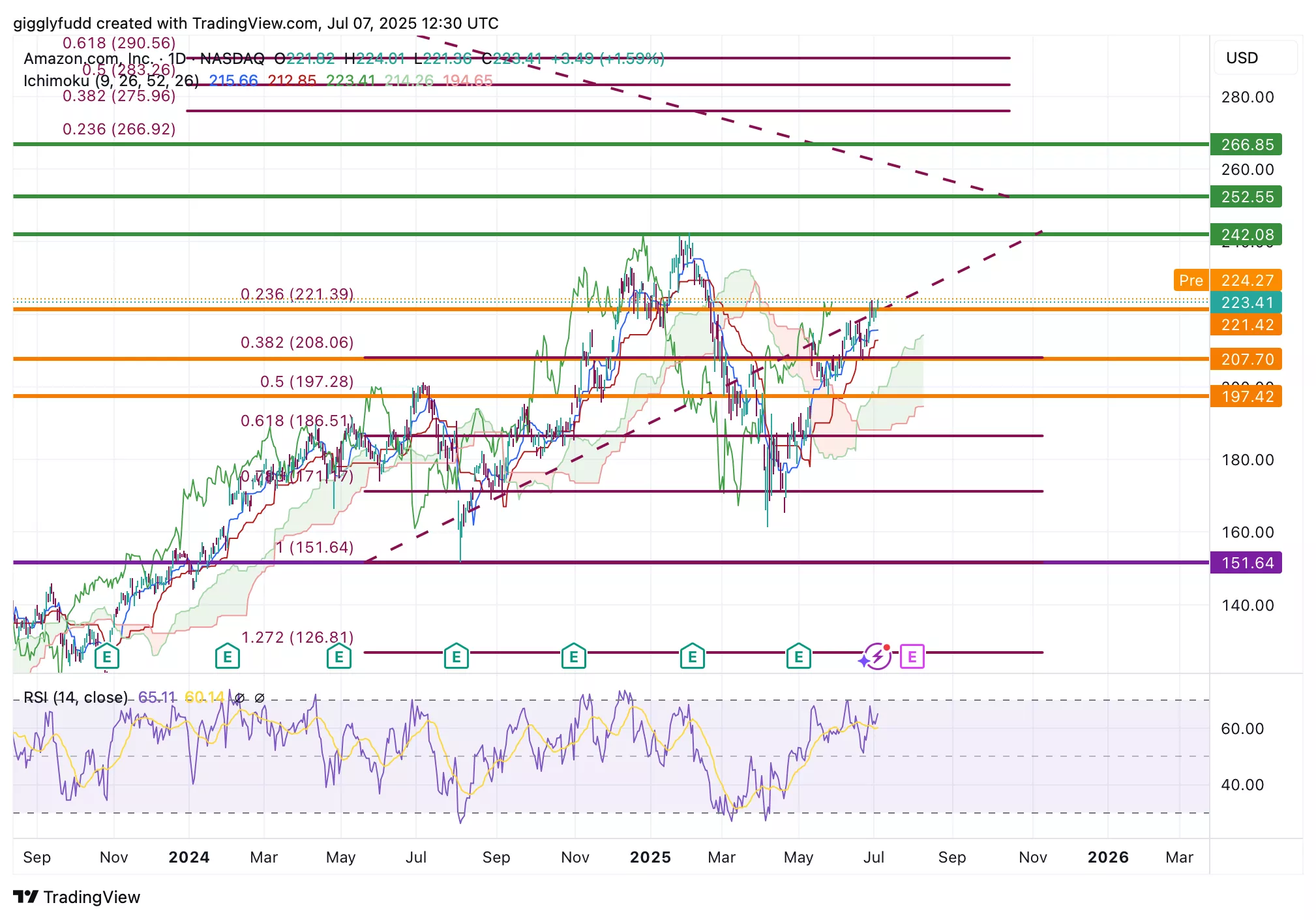Amazon Stock Bold Yet Quiet Robotics Expansion: Why Investors Should Pay Attention Now
Image Source: Unsplash
When it comes to warehouse automation and robotics driven logistics, few companies are as strategically positioned as Amazon (AMZN).
Over the past decade, Amazon has quietly built the largest and most advanced robotics infrastructure in the e-commerce space, now with over 1 million robots assisting in more than 75% of deliveries.
From heavy-lifting bots like Hercules to AI-optimized fleets like DeepFleet, Amazon’s tech stack is transforming fulfillment and delivery at scale.
This isn’t just about efficiency, it’s about margin expansion and long-term dominance. As Amazon continues investing billions annually into fulfillment automation (estimated to be about $7 to 8 billion in 2024 alone), it’s fortifying a competitive moat that’s hard to match.
The strategy? Reduce costs, speed up delivery, and build a logistics empire that operates with precision and minimal human error. In a future where AI and robotics merge, Amazon isn’t playing catch-up, it’s setting the pace.
But this innovation comes with complexity. Labor unions and regulators are beginning to push back, especially in the U.S. and EU, questioning the social and employment impact of mass automation. Amazon’s current approach which is retraining 700,000 workers, suggests a careful balancing act between innovation and responsibility.
There’s also the matter of cash flow: while robotics capex is pressuring free cash now, a major inflection point is expected by 2026, potentially unlocking significant value for investors.
So is Amazon evolving into the most advanced logistics tech company in the world, quietly turning robots into revenue?
Since my last blog on Amazon, I’m reviewing it again using the IDDA Framework: Capital, Intentional, Fundamentals, Sentimental and Technical.
IDDA Point 1 & 2: Capital & Intentional
Before investing in Amazon, ask yourself:
Do you want exposure to multiple high-growth sectors like AI, cloud computing, e-commerce, and digital advertising?
Are you bullish on Amazon’s ability to innovate and expand across industries from logistics to media and AI infrastructure?
Are you comfortable holding a mega-cap stock that reinvests heavily for long-term growth over short-term profits?
Amazon is widely regarded as a global tech powerhouse with unmatched scale and a diversified revenue engine. From AWS, its cloud computing leader, to its fast growing ad business and continued dominance in e-commerce, Amazon sits at the center of several transformative trends. The recent partnership with Roku further deepens its footprint in the connected TV space, expanding ad reach and enabling smarter audience targeting.
That said, Amazon isn’t without risks. Margins in its retail segment remain thin, and regulatory scrutiny continues to be a concern. High capital expenditures in AI and logistics may impact short-term profitability, and with such a vast ecosystem, execution missteps in one segment can ripple across others.
If you’re building a portfolio with exposure to long term innovation, digital infrastructure, and scalable platform economics, Amazon offers breadth, depth, and durability.
Just know: Amazon isn’t a quick win. It’s a long-term compounder for investors who believe in platform ecosystems, enterprise cloud, and the data driven economy.
Amazon is for strategic investors who want a stake in the backbone of global digital transformation with the scale and resilience to keep evolving through every tech cycle.
IDDA Point 3: Fundamentals
Amazon delivered strong performance in Q1 2025, generating $156 billion in revenue, up 9% year-over-year, or 11% when adjusting for foreign exchange effects. Higher-margin segments like AWS, advertising, and subscriptions are outpacing traditional retail growth, driving profitability. Operating margins reached an all-time high of 11.8%, with operating profit growing over 20%, even amid FX headwinds and one-off costs.
Key business drivers remain robust. AWS, Amazon’s cloud arm, is operating at a $120 billion run rate and still has significant room for expansion, with over 85% of global IT workloads still on-premises. The growing demand for AI and cloud services is expected to accelerate AWS’s growth further. On the advertising front, Amazon is fast becoming the third-largest player globally, trailing only Google and Meta, with strong growth across sponsored ads, Prime Video, Fire TV, and Twitch. Retail growth remains slower due to scale, but offerings like Prime subscriptions and ad-supported Prime Video continue to support margin expansion.
Its new partnership with Roku further strengthens Amazon’s position in the connected TV ad space, giving it access to Roku’s expansive smart TV reach and enabling deeper ad integration across platforms. This collaboration is expected to boost ad performance, inventory, and streaming monetization, reinforcing Amazon’s role in the evolving digital advertising ecosystem.
Amazon’s heavy capital investment is focused on future-proofing the business. It’s currently spending around $100 billion annually on capex, largely directed toward AWS infrastructure and robotics. This near-term spending has temporarily suppressed free cash flow, which came in at $36.2 billion in 2024. However, a significant inflection point is expected in 2026, after which both margins and valuation multiples are likely to improve.
A large portion of this capex is fueling Amazon’s robotics revolution. The company has already deployed millions of robots, including Hercules for lifting, Proteus for mobility, and Sparrow for picking. In 2024 alone, an estimated $7 to 8 billion was spent on robotics, about 19% of Amazon’s free cash flow. Each robotics-optimized fulfillment center can cost up to $450 million, indicating a strong long-term investment in automation.
These robotics investments are beginning to pay off. Amazon has reduced headcount in automated warehouses by around 10%, while boosting operational efficiency. Its in-house AI system, DeepFleet, has improved robot productivity by roughly 10%, contributing to margin expansion and improved delivery performance. Over time, this shift is expected to significantly reduce labor costs and enhance fulfillment efficiency.
From an industry perspective, Amazon is not alone in this automation race. Competitors like Walmart, JD.com, and Ocado are also advancing in robotics. However, Amazon’s scale, innovation, and early adoption place it at the forefront. In today’s market, robotics isn’t just a differentiator, it’s becoming a necessity for survival and profitability in large-scale operations.
Fundamental Risk: Low – Medium
IDDA Point 4: Sentimental
Strengths
Robotics & AI Leadership – Amazon has quietly built a massive robotics operation with over 1 million robots now assist in more than 75% of deliveries. It’s well ahead of competitors in automation, which is expected to drive long-term margin expansion.
Favorable Macroeconomic Conditions – A supportive macro backdrop, like low interest rates and improving global stability, is lifting overall sentiment and enabling Amazon to capitalize on growth opportunities in AWS, robotics, and advertising.
20%+ Return Potential – Analysts project at least a 20% upside over the next year. The current valuation does not fully reflect Amazon’s earnings growth, AI edge, or its potential to benefit from weakening competitors like Temu and Shein.
Risks
Regulatory Scrutiny – Amazon’s robotics ambitions face pushback from regulators and labor unions, particularly in the EU and U.S., which could delay ROI or limit aggressive automation rollouts.
Underwhelming Stock Performance – Despite strong earnings and margin growth, Amazon’s stock has been flat in 2025 and underperformed over the past five years. This has shifted investor perception from high-growth to cautious value.
Social & Labor Concerns
– While Amazon is retraining workers, the broader social risk of mass job displacement from automation remains. Any public or political backlash could lead to tighter regulations or reputational risks.
Investor sentiment toward Amazon is cautiously optimistic but still lags the company’s actual transformation. After years of underperformance, many investors now view Amazon through a more conservative, value focused lens, overlooking its rapid advances in robotics, AI, and cloud infrastructure. While the market is still fixated on AI hype, Amazon’s quieter but deeper investment in automation and efficiency has positioned it for a breakout. The stock’s current pricing doesn’t yet reflect these shifts, but sentiment is expected to turn more bullish by 2026 as capex pressures ease, automation begins to pay off, and the company delivers stronger free cash flow and earnings.
Sentimental Risk: Medium
IDDA Point 4: Technical
On the daily chart:
The future Ichimoku cloud is bullish and wide – signaling ongoing upward momentum
The current pattern continues to trend upwards
The pattern, along with the Kijun, Tenkan, and Chikou lines, are above the cloud, which is acting as a support zone
Since my last analysis, Amazon has continued to show strong bullish momentum, with no pullback to any of the previous buy limit entries. The candlesticks remain well above the Ichimoku cloud, and the future cloud remains bullish, confirming the continuation of the uptrend. The current market price is around $223, now approaching a key resistance level at $242.
(Click on image to enlarge)

Investors looking to get into AMZN can consider these new Buy Limit entries:
221.42 (High Risk)
207.70 (Medium Risk)
197.42 (Low Risk)
Investors looking to take profit can still consider the Sell limit levels:
242.08 (Short term)
252.55 (Medium term)
266.85 (Long term)
Here are the Invest Diva ‘Confidence Compass’ questions to ask yourself before buying at each level:
- If I buy at this price and the price drops by another 50%, how would I feel? Would I panic, or would I buy more to dollar-cost average at lower prices? (hint: this question also reveals your CONFIDENCE in the asset you’re planning to invest in).
- If I don’t buy at this price and the stock suddenly turns around and starts going up again, will I beat myself up for not having bought at this level?
Remember: Investing is personal, and what is right for me might not be right for you. Always do your own due diligence. You should ONLY invest based on your own risk tolerance and your timeframe for reaching your portfolio goals
Technical Risk: Medium
Final Thoughts on Amazon
Amazon’s quiet but powerful robotics revolution is reshaping the future of logistics. With over 1 million robots now assisting in more than 75% of deliveries, Amazon has built the most advanced fulfillment automation network in the world.
In 2024 alone, the company spent an estimated $7 to 8 billion on robotics, part of a broader $100 billion capex strategy focused on scaling AWS, AI, and logistics. Robots like Hercules, Proteus, and Sparrow are already cutting labor costs, boosting productivity, and improving delivery precision, while Amazon’s DeepFleet AI has driven robot efficiency up by 10%.
Despite near-term cash flow pressure and rising regulatory scrutiny, Amazon’s approach to retraining 700,000 employees reflects a long-term, responsible innovation strategy.
When paired with its recent partnership with Roku in connected TV advertising and steady growth across AWS and digital ads, Amazon is not just dominating retail, it’s becoming a global force in tech-led infrastructure and automation.
Recommendation: Buy / Low-Medium Risk, Long-Term Compounder
Amazon remains a high conviction play for investors seeking exposure to robotics, AI, cloud, and scalable digital ecosystems. While short term margins may be impacted by high reinvestment, the long-term upside is supported by margin expansion, multi-sector dominance, and operational resilience.
Overall Stock Risk: Low Medium
More By This Author:
BigBear.ai Stock: Missed Palantir? This Might Be Your Second ShotNvidia Stock: Why This May (Or May Not) Be The Best Time To Invest
Could Robinhood Stock’s 110% Ytd Gain Be Just The Tip Of The Iceberg?




